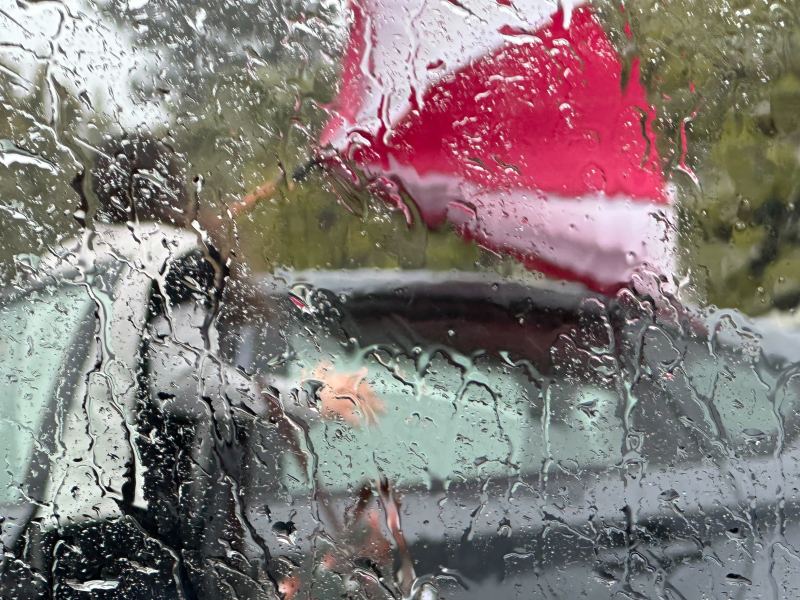Winter quarter was one of unexpected weather for many Stanford students. Between high winds and rain from atmospheric rivers loosening up soil, several trees were downed in winter quarter. On Feb. 21, Zane St. John ’26 was walking past Green Library when he was almost hit by a falling tree.
“Five seconds after I walk under the tree, I hear a loud noise behind me, and I look behind me, and the tree’s just done,” said St. John. “That could have been me.”
Emily Liang ’24 said the weather disrupted her commutes to classes. For Liang, the weather was not just a hindrance, but its variability was a point of confusion. “The weather these past couple of weeks have been insane and very inconsistent. Just the other day, it was extremely sunny and warm while it was raining. And then that same night, it got super windy and cloudy,” she said.
Perhaps most surprising was the fact that Lake Lagunita, a now-typically dry lake, was filled for the duration of winter quarter.
Many students like Liang found this weather unusual. According to the National Ocean and Atmospheric Administration (NOAA), California’s San Francisco area has received more precipitation in the first three months of 2023 than all the precipitation in 2022 combined.
But, are the weather events of 2023 truly unique when put on a longer timeframe?
Chris Field Ph.D. ’81, Director of the Woods Institute and Interdisciplinary Environmental Studies at Stanford University, said the weather California has seen this past winter isn’t anything new, but the overall climate trend is.
“California’s weather has always been marked by extreme[s]. And, it’s common to historically have very, very dry periods and very, very wet periods.”
“One of the things we know about a changing climate is that the variability tends to increase,” Field said.
Field claimed that the increase in yearly weather variability is consistent with predictions from climate change models. “Based on [climate change] forecasts, it’s not obvious that we should see consistent change in the annual precipitation, but there’s good evidence that we’re already seeing an increase in year to year variability.”
In the first three months of 2023, the San Francisco area received 19.31 inches of precipitation, rainwater and snowfall, while the sum of all the precipitation from 2022 was 13.42 inches. In 2020, the area got just 5.86 inches.
In addition, California’s winter of 2023 saw a record-breaking 17.5 feet of snow in Lee Vining, Calif. just outside of Yosemite National Park.
According to NOAA, atmospheric rivers form when warm temperatures in the tropics drive ocean water to evaporate and winds blow this vapor to the western U.S. by winds, where it falls as precipitation.
Why did more atmospheric rivers hit California this past winter than in previous years? Field said that while some climate features are easily predictable, some features are much more difficult to forecast. “It’s not that we don’t understand them, it’s that we understand that they are intrinsically chaotic. And that’s things like exactly where these atmospheric rivers will hit,” Field said.
“They’re susceptible to, kind of, the mathematical definition of chaos, which is: very small differences in the initial conditions can lead to large differences in the way things play out,” Field said.
Daniel Swain, Ph.D. ’16, is a climate scientist at the University of California Los Angeles (UCLA) who works to communicate the science behind these weather events to the general public. Through his blog and YouTube channel, both named “Weather West,” he explains the weather phenomena impacting California in almost real time.
On the question of whether these weather events are climate-change related, Swain concurs with Field in an explanation from his YouTube channel, saying the weather events of the past quarter are aligned with what climate models predict. That being, “increasingly whiplash-y hydroclimate In California.”
In one of his YouTube livestreams, Swain explained the rain California saw in late March was a result of a type of atmospheric river called a “Pineapple Express,” which moves water originating near Hawaii to the western U.S
Prior to atmospheric rivers hitting California in March, Swain explained the event on his YouTube channel. “Are those actual water molecules from the subtropics falling as rain in California? Often, the answer is no. But in this case…it does appear that a lot of the water that’s about to fall on California really did originate in the ocean near the Hawaiian Islands,” Swain said.
As climate change continues to drive changes in weather, this year will almost certainly not be the last time California sees a series of atmospheric rivers. Swain has explained that the atmosphere has the capacity to release more precipitation than before because warmer air can hold more water. As climate change continues to raise average atmospheric temperatures, this capacity will only grow.
In his explanation on his YouTube channel, Swain also clarified that a wet winter does not necessarily mean California is safe from a damaging fire season. Instead, the precipitation we’re currently experiencing is leading to the growth of more undergrowth, and with trees being downed by high winds, all that vegetation may end up being fuel for a particularly damaging fire season. It all depends on how hot and dry spring and summer are this year in California.
As for floods, according to Swain, there is little risk of flooding from snowmelt yet, but as temperatures rise in early April, there’s the potential for that record snowfall to all melt very rapidly, causing disastrous flooding.
“There just really isn’t any mechanism to melt a lot of that high elevation snowpack yet, but eventually it’s going to happen, and the question is whether it happens quickly versus slowly,” Gradual versus rapid snowmelt will be the difference between minor and potentially severe flooding this spring, Swain said.
